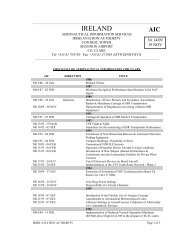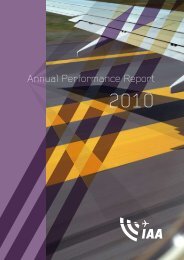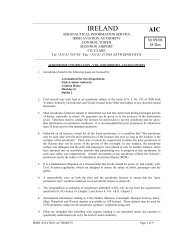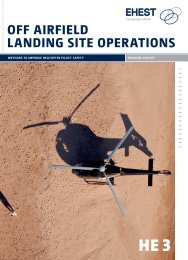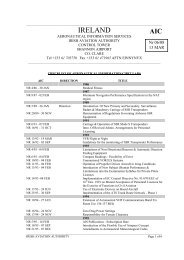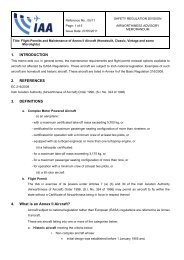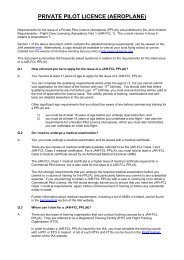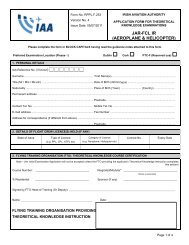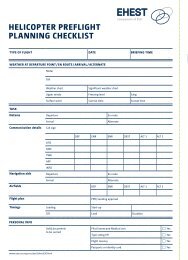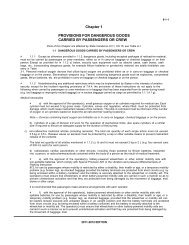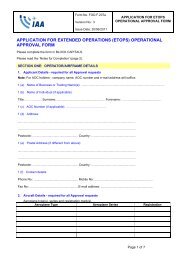AIP ENR 1.2-1 IRELAND 08JUNE 06 IRISH AVIATION AUTHORITY ...
AIP ENR 1.2-1 IRELAND 08JUNE 06 IRISH AVIATION AUTHORITY ...
AIP ENR 1.2-1 IRELAND 08JUNE 06 IRISH AVIATION AUTHORITY ...
Create successful ePaper yourself
Turn your PDF publications into a flip-book with our unique Google optimized e-Paper software.
<strong>AIP</strong> <strong>ENR</strong> <strong>1.2</strong>-1<br />
<strong>IRELAND</strong> <strong>08JUNE</strong> <strong>06</strong><br />
<strong>ENR</strong> <strong>1.2</strong> Visual Flight Rules<br />
1. General<br />
Visual Flight Rules are prescribed in the Irish Aviation Authority (Rules of the Air) Order, 2004.<br />
2. Rule 34. General Rules for VFR flights<br />
2.1. Classification of airspace<br />
Except when operating as a special VFR flight, VFR flights shall be conducted so that the aircraft is flown in<br />
conditions of visibility and distance from clouds equal to or greater than those specified in the following table:<br />
1} Airspace class A 2} BCDE FG<br />
FG<br />
Distance from<br />
Cloud<br />
Above 900 metres (3,000 ft) AMSL<br />
or above 300 metres (1,000 ft)<br />
above terrain whichever is the<br />
higher<br />
1,500 metres horizontally 300 metres (1,000 ft)<br />
vertically<br />
Flight Visibility 8 Kilometres at or above Flight Level 100 or 10,000<br />
ft AMSL<br />
5 Kilometres below Flight Level 100 or 10,000 ft<br />
AMSL<br />
1} See Rule 26 of these Rules<br />
At and below 900 metres (3,000<br />
ft) AMSL or 300 metres (1,000 ft)<br />
above terrain whichever is the<br />
higher<br />
Clear of cloud and in sight of the<br />
surface<br />
5 Kilometres 3}<br />
2}<br />
VMC minima in Class A airspace are included for guidance to pilots but do not imply the acceptance by the<br />
ATS Unit responsible of a VFR flight in Class A airspace in a particular instance;<br />
3}<br />
a) 3 kms, flight Visibility for aircraft operated at an indicated airspeed of 140 kts or less<br />
b) lower flight visibilities to a minimum of 1500m may be permitted for aircraft operating:<br />
1) at speeds that, in the prevailing visibility will give adequate opportunity to observe other<br />
traffic or any obstacles in time to avoid collision, or<br />
2) in circumstances in which the probability of encounters with other traffic would normally be<br />
low, e.g. in areas of low volume traffic and for aerial work at low level;<br />
c) A helicopter may be permitted to operate in less than 1500m flight visibility where a lower flight<br />
visibility is prescribed by the Authority, if manoeuvred at a speed that will give adequate opportunity to<br />
observe other traffic or any obstacles in time to avoid collision.<br />
2.2. Helicopter Operations<br />
If the aircraft is a helicopter operating in class G airspace it may, unless otherwise prescribed, be flown below<br />
300 metres (1,000 ft), but not below 150 metres (500 ft), above terrain or water in a flight visibility of not less<br />
than 1,000 metres, or such lesser visibility as may be prescribed by the Authority, and in such case shall remain<br />
clear of cloud and in sight of the surface and shall be manoeuvred at a speed which would give the pilot-incommand<br />
adequate opportunity to observe other traffic or any obstruction in good time to avoid collision.<br />
2.3. When within a control zone, an aircraft may be operated as and in meteorological conditions appropriate<br />
to a special VFR flight provided that the flight may be conducted in accordance with Rule 3 of these<br />
Rules.<br />
2.4. In this Rule, a special VFR flight means a controlled flight authorised by the appropriate air traffic<br />
control unit to operate within a control zone:<br />
2.4.1. by day, in meteorological conditions which are lower than the Visual Meteorological Conditions but<br />
with a flight visibility not less than 1500m and clear of clouds and in sight of the surface, except in the<br />
case of a helicopter operating in accordance with Rule 3(2)(b) of these rules along a prescribed route or<br />
<strong>IRISH</strong> <strong>AVIATION</strong> <strong>AUTHORITY</strong> AIRAC AMDT 46
<strong>ENR</strong> <strong>1.2</strong>-2<br />
<strong>08JUNE</strong> <strong>06</strong><br />
<strong>AIP</strong><br />
<strong>IRELAND</strong><br />
within a prescribed area where such are prescribed and where lower limits are prescribed relating<br />
thereto; 51<br />
2.4.2. by night, in Visual Meteorological Conditions and in sight of the surface.<br />
2.5. At an aerodrome within a control zone, special VFR flights shall not be authorised to land,, take off,<br />
depart, cross the control zone or operate locally therein if the ground visibility within the control zone is<br />
less than 1500m and/or the reported cloud ceiling is less than 500 feet, except in the case of a helicopter<br />
operating in accordance with Rule 3(2)(b) of these rules, along a prescribed route or within a prescribed<br />
area where lower limits are prescribed.<br />
2.6. Except when a special VFR clearance is obtained from an air traffic control unit, VFR flights shall not<br />
take-off or land at an aerodrome within a control zone or enter the aerodrome traffic zone or traffic<br />
pattern:<br />
2.6.1. when the ceiling is less than 450 metres (1,500 ft); or<br />
2.6.2. when the ground visibility is less than 5 km.<br />
2.7. Except where otherwise indicated in air traffic control clearances or specified by the appropriate ATS<br />
authority, VFR flights in level cruising flight when operated above 900 metres (3,000 ft) above the<br />
ground or water, or a higher datum as specified by the appropriate ATS authority, shall be conducted at<br />
a flight level appropriate to the track as specified in the table of cruising levels in Rule 4 of these Rules.<br />
2.8. VFR Flights at Night<br />
2.8.1. VFR flights at night operated in a control zone shall be operated as special VFR flights subject to a<br />
clearance from the air traffic control unit responsible for that zone and elsewhere in accordance with the<br />
conditions prescribed by the Authority or, in any other state, the appropriate ATS authority;<br />
2.8.2. Special VFR flights at night authorised in a control zone may only operate to or from aerodromes or<br />
heliports suitably equipped for night operations;<br />
2.8.3. Flights by night outside a control zone shall be operated as IFR flights in accordance with Part IV of the<br />
Rules in this Order unless otherwise prescribed or authorised by the Authority.<br />
2.9. Unless authorised by the appropriate ATS authority, VFR flights shall not be operated:<br />
2.9.1. above FL200;<br />
2.9.2. at transonic and supersonic speeds.<br />
2.10. VFR flights which are operated within Classes B, C, and D airspace or as special VFR flights shall<br />
comply with the provisions of Rules 27 to 31.<br />
2.11. A VFR flight operating within or into areas, or along routes, designated by the appropriate ATS<br />
authority in accordance with Rule 23 paragraph (2)(c) or (d), shall maintain continuous listening watch<br />
on the appropriate radio frequency of, and report its position as necessary to, the air traffic services unit<br />
providing flight information service.<br />
AIRAC AMDT 46<br />
<strong>IRISH</strong> <strong>AVIATION</strong> <strong>AUTHORITY</strong>
<strong>AIP</strong> <strong>ENR</strong> <strong>1.2</strong>-3<br />
<strong>IRELAND</strong> <strong>08JUNE</strong> <strong>06</strong><br />
3. Rule 35. Change from VFR to IFR flight<br />
An aircraft operated in accordance with the Visual Flight Rules which wishes to change to compliance with the<br />
Instrument Flight Rules shall:<br />
3.1. if a flight plan was submitted, inform the appropriate air traffic services unit of the necessary changes to<br />
be effected to its current flight plan, or<br />
3.2. when so required by paragraph (2) of Rule 23 submit a flight plan to the appropriate air traffic services<br />
unit and obtain a clearance prior to proceeding in accordance with the Instrument Flight Rules when in<br />
controlled airspace.<br />
<strong>IRISH</strong> <strong>AVIATION</strong> <strong>AUTHORITY</strong> AIRAC AMDT 46
<strong>ENR</strong> <strong>1.2</strong>-4<br />
<strong>08JUNE</strong> <strong>06</strong><br />
<strong>AIP</strong><br />
<strong>IRELAND</strong><br />
Intentionally Blank<br />
AIRAC AMDT 46<br />
<strong>IRISH</strong> <strong>AVIATION</strong> <strong>AUTHORITY</strong>




